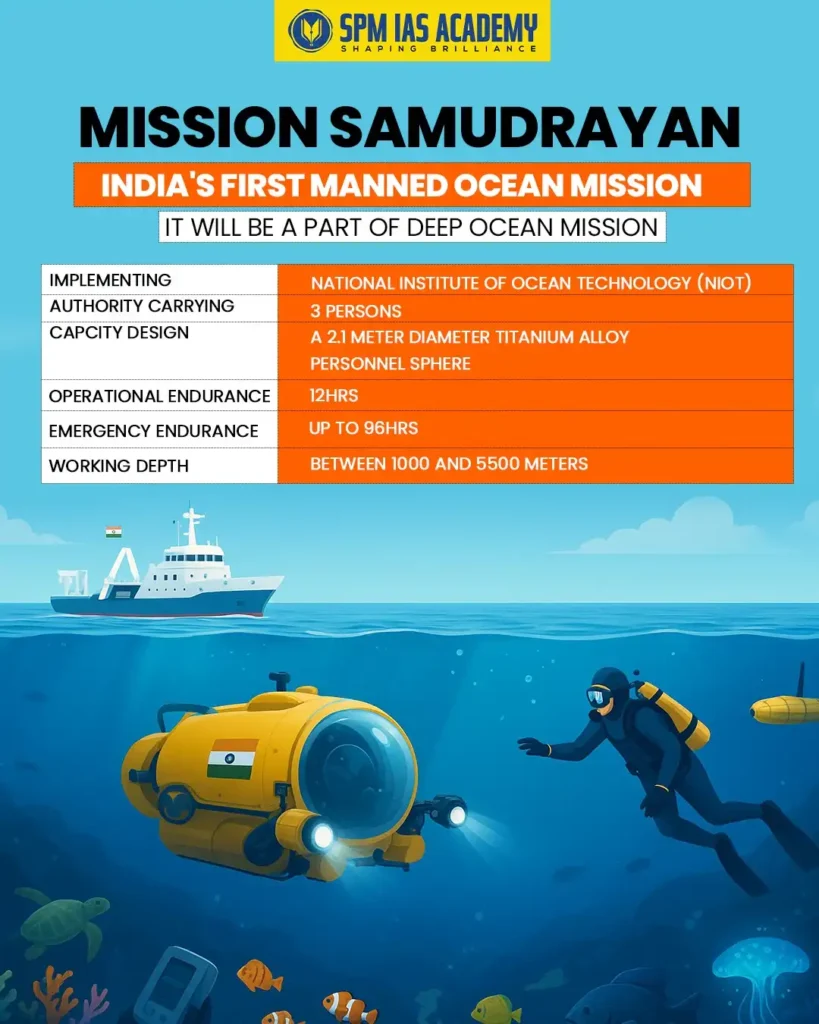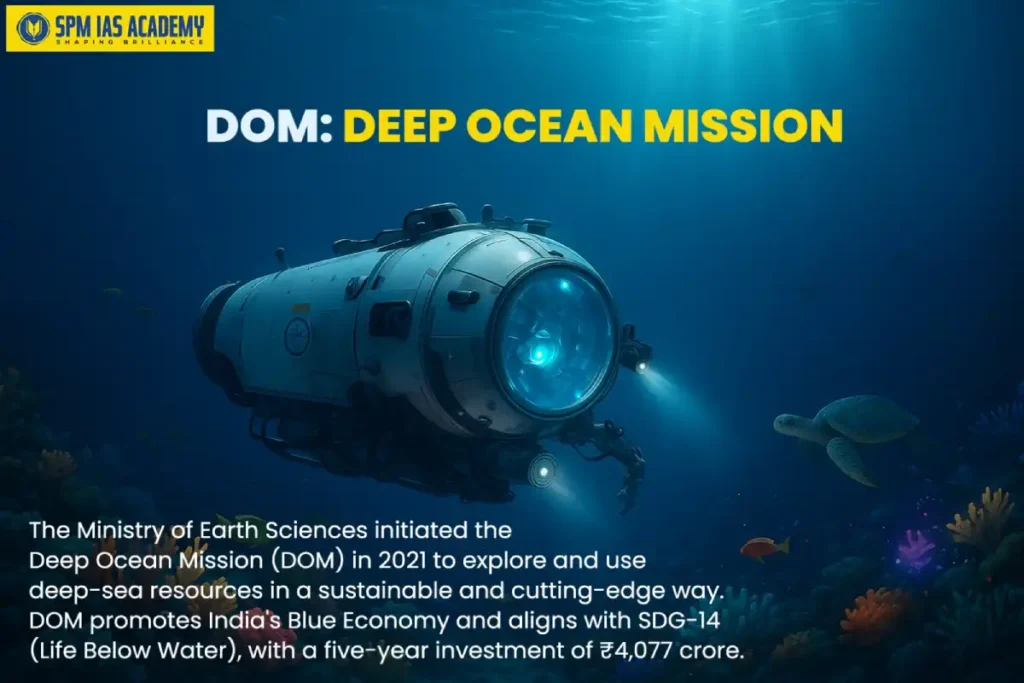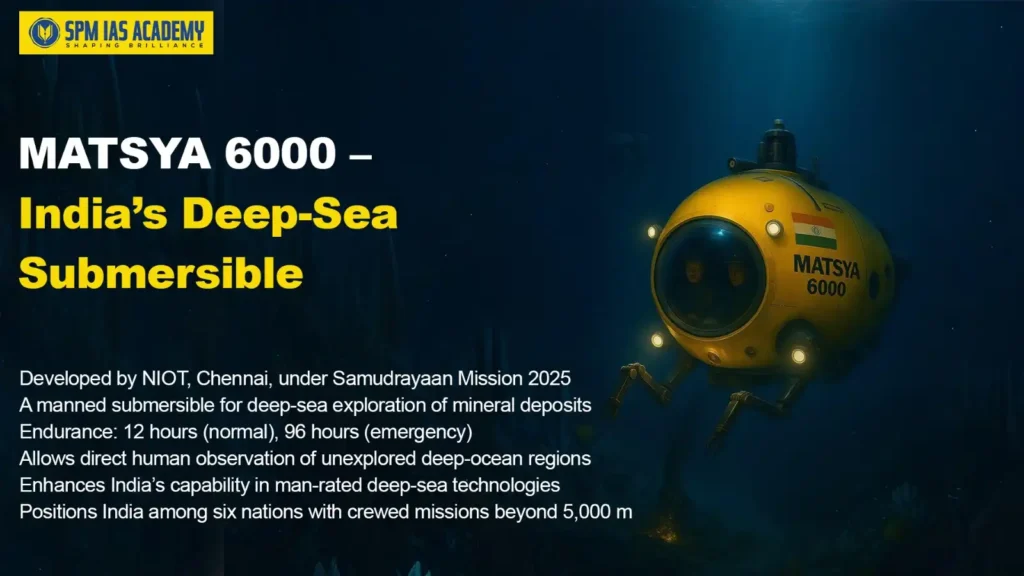Why is the news?
By 2026, India plans to conduct "Samudrayaan," its first human deep-ocean mission. The goal is to use the domestically built submersible "Matsya" to investigate marine resources at a depth of 6,000 meters.
What is Samudrayaan Mission 2025?

The Samudrayaan Mission 2025 is India’s first human ocean mission to explore the deep ocean. The mission aims to develop a self-propelled submersible that is capable of carrying three people to depths of 6,000 meters. The submersible will study ocean resources and assess biodiversity while protecting the ecosystem. This project is part of the Deep Ocean Mission, which supports the Central Government’s Blue Economy policy and is managed by the Ministry of Earth Sciences (MoES).
- To explore deep-sea resources, including minerals, the expedition will send three personnel in a vehicle known as the “MATSYA 6000” to a depth of 6000 meters.
- The National Institute of Ocean Technology (NIOT), Chennai, under the Ministry of Earth Sciences, is designing and developing the “MATSYA 6000” vehicle.
- Under typical operating conditions, it can last 12 hours. Additionally, if there is an emergency involving human safety, it can last up to 96 hours.
- It is a component of the ₹6000-crore Deep Ocean Mission and is India’s first special manned ocean mission.
Significance of Samudrayaan Mission 2025
Below summarizes the significance of the Samudrayaan mission 2025:
1. Scientific Research: The mission will enable the collection of deep-sea samples. These samples are critical for understanding geology, marine biodiversity, and chemistry.
2. Resource Exploration: The mission provides the potential for the assessment of living (marine biodiversity) and non-living resources (minerals, polymetallic nodules).
3. Technology Demonstration: This mission demonstrates the skills of local experts in deep-sea exploration in India under high-pressure conditions.
4. Tourism Potential: The mission may lay the foundation for future deep-sea tourism.
5. Strategic Capability: The mission will enhance India’s presence in global ocean research and resource diplomacy.
6. League of Nations: With this mission, India will become a part of a selected group of nations that have the technology and capabilities for manned deep-sea exploration. This group includes the US, Russia, France, Japan, and China.
What are the Objectives of the Samudrayaan Mission 2025?
Below are the Samudrayaan mission objectives:
- To research the ecology, variety, and distribution of deep-sea marine life.
- To investigate the range of polymetallic nodules, which are abundant in cobalt, nickel, and copper.
- To research how the ocean’s temperature, acidity, and circulation are affected by climate change.
- To advance India’s capacity for deep-sea research and exploration, as well as for the development of underwater robotics and vehicles.
- To supply clean drinking water, investigate water desalination options, and develop offshore-based desalination and sustainable energy generation methods.
What is the Deep Ocean Mission?

In June 2021, the Ministry of Earth Sciences approved this mission. The Deep Ocean Mission aims to promote the Indian government’s Blue Economy Initiatives. It focuses on developing deep-sea technologies for the sustainable use of ocean resources, including deep-sea exploration in India.
Additionally, the mission aims to explore the deep ocean for potential resources. The Mission will be completed in phases and is expected to cost ₹4,077 crores over five years.
DOM: Deep Ocean Mission
- The Ministry of Earth Sciences initiated the Deep Ocean Mission (DOM) in 2021 to explore and use deep-sea resources in a sustainable and cutting-edge way.
- DOM promotes India’s Blue Economy and aligns with SDG-14 (Life Below Water), with a five-year investment of ₹4,077 crore.
Components of DOM
The National Institute of Ocean Technology (NIOT) is leading the mission. Below are its six components:
- Manned Submersible Development (Samudrayaan).
- Deep-sea Biodiversity Exploration.
- Mining Polymetallic Nodules.
- Ocean Climate Advisory Services.
- Marine Station for Ocean Biology to promote research.
- Advanced Ocean Observation Systems using underwater sensors and AI.
What is MATSYA 6000?

- Chennai’s National Institute of Ocean Technology (NIOT) created MATSYA 6000. It is a manned submersible vehicle.
- It was created as part of the Samudrayaan mission 2025 to help people explore mineral deposits in the deep ocean.
- Its operational duration is 12 hours, and in an emergency, it can last for 96 hours.
- Through direct interventions, scientists will be able to view and comprehend previously uncharted deep-sea regions. Additionally, it will improve the capacity for developing man-rated deep-sea vehicles.
- Upon launching the MATSYA 6000, India will join the six nations—the US, Russia, Japan, France, and China—that have successfully conducted a crewed undersea mission. This mission will go beyond 5,000 meters.
Samudrayaan Mission 2025: Launch Date
On June 16, 2021, the Ministry of Earth Sciences’ (MoES) proposal for a “Deep Ocean Mission” was approved by the Cabinet Committee on Economic Affairs (CCEA). In October 2021, the Ministry of Earth Sciences launched the Deep Ocean Mission as a central sector scheme. These are all a part of the Samudrayaan mission 2025.
The Ocean Mineral Explorer (OMe 6000), a deep-water autonomous underwater vehicle (AUV), has been sent out for exploration as part of the mission. The research ship Sagar Nidhi was used for deep-sea mineral exploration in December 2022. The OMe 6000 AUV conducted its operations at the Polymetallic Manganese Nodule (PMN) location. This site is located at a depth of 5,271 meters in the International Seabed Authority’s designated area of the Central Indian Ocean Basin (CIOB).
For the past two years, Indian scientists have been working on and evaluating the Matsya 6000 submersible. In 2024, the Matsya 6000 submersible underwent its first unmanned sea trials in the Bay of Bengal off the coast of Chennai. It is anticipated that the mission will be accomplished by 2026.
Conclusion
In conclusion, the Samudrayaan Mission 2025 marks a pivotal step for India in human deep-sea exploration. This mission aims to improve scientific research, assess resources, and drive technological innovation. It will place India among a few nations with such capabilities. The MATSYA 6000 submersible demonstrates India’s commitment to utilizing ocean resources responsibly. As we look forward to its launch, the mission represents a significant step in exploration and strengthens India’s role in global marine science, promoting the responsible use of our ocean resources.
Frequently Asked Questions
A: India’s Samudrayaan Mission 2025 aims to explore the deep sea. The mission is developing a manned submersible called MATSYA 6000. The National Institute of Ocean Technology (NIOT) is working on this project under the Ministry of Earth Sciences.
A: The Samudrayaan Mission is developing a manned submersible capable of holding three people and diving to a depth of 6,000 meters. It will have scientific sensors for exploring the deep ocean. The submersible can operate for 12 hours and extend to 96 hours in emergencies.
A: Matsya 6000 is India’s first manned submersible, developed by the National Institute of Ocean Technology (NIOT) in Chennai. It can carry a crew of three and dive to depths of 6,000 meters. This submersible is part of the Samudrayaan Project, which is under the Deep Ocean Mission.
A: The budget allocated in the Union Budget 2025-26 to the Samudrayaan Mission is ₹600 crore.
A: With its launch, India will become the sixth country (after the US, Russia, Japan, France, and China) to have a crewed undersea expedition.












